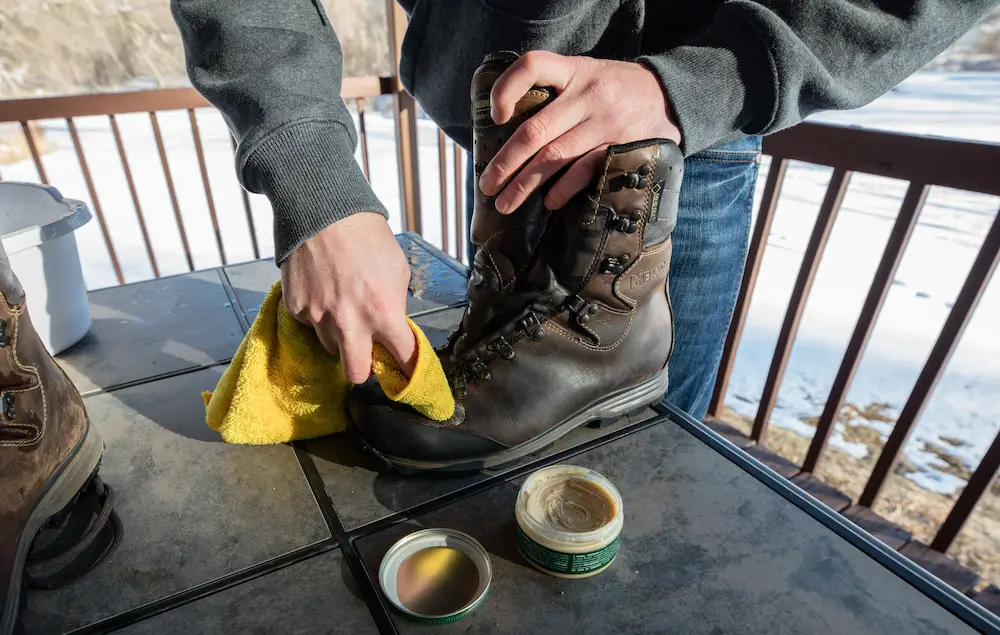Whether you’re a regular hiker or just enjoy wearing boots for your regular walks, walking boots are designed just for you.
They’re quite strong and resilient, and are precisely manufactured to provide a solid defence against various weather conditions and uncertain surfaces.
However, if you want your walking boots to last for a long time, a little attention and care must be given to achieve that.
There are various approaches when it comes to taking care of your walking boots, however, waxing and conditioning is essential in maintaining their longevity.

Essentially, you need to apply wax on your walking boot once every month. But it also depends on the usage and the environment in which they are frequently being used.
You can also identify when wax needs to be applied by carefully observing your boots. If they look dry and brittle, then you have to go ahead with the process to avoid further damage.
However, waxing too much will lead the material of your walking boot to soften, thereby diminishing its strength.
If you can give us a few minutes of your time, this article will answer all your questions regarding the care and maintenance of your walking boots.
Importance of walking boots:
-
-
- Safety and support
- They’re more durable than regular shoes
- Solid grip even on uncertain surfaces
- They’re water-resistant and hence keeps your feet dry
- They’re sturdy but overall comfortable
-
Reasons why it’s important to wax walking boots
1.) To maintain the water-repelling quality of the boot
Heat, moisture and humidity have a negative impact on leather that makes up your walking boot. Water will linger on the surface and eventually soak into the footwear if boots are not properly treated, compromising on the quality of the boots.
Water beads do not reach the inner boot when you get it treated with wax and regular conditioning.
2.) To maintain the suppleness and durability of walking boots
Because leather is sensitive to moisture and temperature changes, it is necessary to treat boots and shoes to prevent them from drying out.
Walking boots already come with water-resisting features, but adding an extra layer of wax will go a long way to prevent cracks and stiffness on your walking boot.
Conditioning your walking boots help to retain moisture while keeping dirt and rain out, allowing for utmost flexibility and suppleness for a longer period of time. It is also essential to keep your boots looking healthy and new for long.
3.) To keep the walking boot breathable
Leather is a naturally breathable material, and walking boots made of leather does provide comfort and heat regulation.
Dust, muck and moisture can clog the leather and hinder your feet from breathing, resulting in hot, sweaty feet.
Therefore, applying a layer of wax after cleaning the walking boot is essential to maintain their breathability.
4.) To maintain the appearance of the walking boot
Wax treatments nourish the leather, resulting in a healthy appearance of your walking boots that will protect your feet for miles.
You rely on walking boots to protect you from external elements, and it exactly does so and all it asks is just a little care in return.
How to maintain your walking boots?
Proper maintenance is required for your walking boots to function well and give you all its benefits.
Here is a step by steps method on how to clean and apply wax (condition) your walking boots-
Cleaning
The first step is to clean off any mud or dirt that has accumulated on the boots. This should be done with a firm brush.
Remove the laces and inside sole to gain access to all of the nooks and crannies. These can be washed individually or simply removed and set aside for ease of use if they don’t require much washing.
Scrub the walking boots with a gentle brush while they are submerged in warm water. To remove the dirt that has accumulated on them, use a little dishwashing liquid or a boot cleaning agent.
Check out this leather cleaner by Chemical Guys
- It’s not just for car seats & interiors: This kit works on all things leather, seats, interiors, jackets, shoes, sneakers, boots, sofas
- Treat your leather like your hair & skin
- PH Balanced: Leather cleaner is pH balanced for the most efficient cleaning and preserves the leathers strength, durability and appearance
- Satisfaction guaranteed: Our customers love our products. We love our products, and we want to make sure you love them too.
Prices pulled from the Amazon Product Advertising API on:
Product prices and availability are accurate as of the date/time indicated and are subject to change. Any price and availability information displayed on [relevant Amazon Site(s), as applicable] at the time of purchase will apply to the purchase of this product.
-
-
- Simply wash away the lather.
- If you want to get rid of odors on the inside of your boot, use warm water with a pinch of salt dissolved on the inside of the boot. Allowing a boot to air dry is preferable instead of using heat, which will damage the leather.
-
Conditioning
If your walking boots are water-resistant, they may still need to be reproofed to maintain their water-repelling properties.
1.) Once your walking boots are dry, simply take your boot wax and ensure that it completely covers the surface with the help of a shoe brush or soft cloth, paying special attention to the stitching.
A neutral-colored cream or wax is useful because it can be used on all of your leather boots and shoes, but an exact shade of colored wax is better for hiding blemishes and scratches. Let the product settle on your boots.
Check out this Danner Boot Dressing–
- Prevents drying and cracking
- Prevents scuffs and scratches
- May be used on all leather items, except nubuck or suede
Prices pulled from the Amazon Product Advertising API on:
Product prices and availability are accurate as of the date/time indicated and are subject to change. Any price and availability information displayed on [relevant Amazon Site(s), as applicable] at the time of purchase will apply to the purchase of this product.
2.) Buff the boots thoroughly with the brush or cloth. You’re not trying to remove the wax that’s still on the surface, but rather to work it into the leather.
Buff all portions of the boot. You will see a significant improvement in the leather’s surface, which should appear smoother, darker, and healthier.
3.) If you frequently use the boots in damp environments like swamps, or wet grass, it’s never a bad idea to repeat the process, adding more wax or conditioner for maximum water resistance.
4.) Stuff the boots with newspaper and set them aside to dry naturally for a few hours. It’s important to remember not to dry them in direct sunlight.
Important note: Not all leathers are the same, therefore walking boots too, are made up of different varieties of leather that require a slightly different treatment than full grain leather. They are suede and nubuck leather.
You cannot use leather products on suede and nubuck. They require conditioners that have been specially designed for their unique appearance.
Check out this Otter Wax for Suede and Nubuck leather, that only only cleans but also replenishes the material-
- Premium quality formula: This professional care product is made with the ultimate quality all-natural biodegradable formula with 100% all-purpose ingredients, combining the unique blend of Aloe Vera and Vitamin C for the best repairing treatment results on delicate leather.
- Easy application: Unlike similar products on the market, this leather conditioner is easy to apply even by novices, with no skills or special brushes required! Simply shake, make sure the surface of the leather is clean, dispense oil to a soft cloth, and apply using a smooth circular motion.
Prices pulled from the Amazon Product Advertising API on:
Product prices and availability are accurate as of the date/time indicated and are subject to change. Any price and availability information displayed on [relevant Amazon Site(s), as applicable] at the time of purchase will apply to the purchase of this product.
What if you excessively wax your walking boots?
There are two drawbacks to using a lot of wax. First using too much of it will crack, leaving an unpleasant white substance behind.
Any boot brush can be used to remove it, but prevention is the ideal option. Keep wax to a bare minimum around the flexing parts of the shoe.
Another issue is that it can cause your walking boots to dry out. Remember that this is a protective layer, so if you use too much wax, your shoes will be unable to absorb the moisture that conditioners and lotions provide. This can cause it to dry out and break, which you won’t be able to fix.
Now, leather wax, oils and cream all come under the conditioning category. However there are slight differences among these. Here is a comparison between them.
Conditioners
The purpose of a leather conditioner is to replenish the natural fibres of the leather in order to restore and preserve flexibility.
Leather conditioner is often used on a regular basis to help prevent cracks and dryness, and is generally used to cure minor damage to the leather caused by dirt exposure.
There are two types of leather conditioners: oils and creams.
Conditioning creams have the advantage of causing minimum color change and keeping the leather fibres supple.
Has to be applied more frequently than wax and mink oil.
However, color change does happen so it’s ideal to test it on a small patch first.
Wax
Leather wax is essential for cleaning, concealing scuffs, sealing, and protecting leather.
It gives your walking boots a protective covering to make them a little more water resistant.
You can only get a delicate, matte look with cream polish. You can make things a little glossier with wax polish. However, you’ll obtain a mirror polish if you use enough of it.
Talking about its drawbacks, many people appreciate the superior shine, but unlike moisturising leather conditioners, leather wax builds up and dries your boots with time.
Mink oil
Mink oil is used to cure, condition, and preserve practically all types of leather due to its unique palmitoleic acid content. It’s highly resistant to damage, and it won’t rot easily.
Because leather is such a permeable material, it can absorb a lot of oil. As a result, feeding leather the proper kind of oil is important for your boots nourishment and suppleness.
Mink oil is used to restore highly damaged, dried-out, and worn-out leather.
The main uses of mink oil on leather is to preserve, waterproof, and protect it against mold, dampness, salt, scratches, and other factors.
However, it has one disadvantage, it tends to darken leather by a few shades because it clogs the pores.
Conclusion
Walking boots are essential as they provide safety and comfort while you walk or hike. Therefore, its care and maintenance is also essential.
There are various ways you can take care of your walking boots, but be vigilant and read all the differences between these oils, conditioners and wax and how to properly use them.
You have to take care of your boots considering the material used in its manufacturing and after each use, they must be washed down, cleaned, and dried, while reproofing, waxing, or polishing can be done as needed or after several sessions of use.










